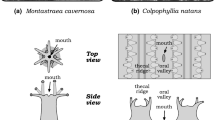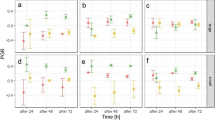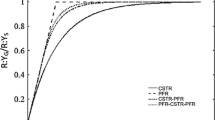Abstract
An experimental setup was designed for in situ videotape recording of the particle capture process in the crown of the polychaete Sabella penicillus. Intact individuals of S. penicillus (collected in the Gullmornfjord, Sweden in 1992) were exposed to either 6 μm Latex spheres or Rhodomonas sp. flagellate cells (6 μm). The capture of the added particles was recorded on video. From frameby-frame analyses particle velocities were estimated and the shape of the three-dimensional particle paths was inferred. The mean velocity of particles approaching the crown was estimated to be ca. 1 mm s-1, increasing to ca. 1.7 mm s-1 in the interpinnule channel. At the moment of capture the particles were seen to follow a curved, near circular path close to the tips of the latero-frontal cilia. The transport velocities on the frontal side of the pinnules and filaments were estimated to be up to 0.15 and 0.5 mm s-1, respectively. Counting captured particles relative to particles arriving within the area of the pinnules gave a rough, direct estimate of nearly 100% retention rate when the polychaete was feeding undisturbed. Together with results from clearance measurements in the literature this implies that the worm is able to capture particles down to 3 μm entering the interpinnule channel almost 100% effectively. In view of the 80-μm wide interpinnule channel and 40-μm spacing between the tips of the latero-frontal cilia on both sides of the channel, this result cannot be explained by mechanisms based solely on direct mechanical contact between cilia and particles but must involve fluid mechanical mechanisms. The present work is the experimental basis for ongoing numerical simulations of the particle motion in the interpinnule channel.
Similar content being viewed by others
References
Blake JR (1971 a) A spherical envelope approach to ciliary propulsion. J Fluid Mech 46: 199–208
Blake JR (1971 b) Infinite models for ciliary propulsion. J Fluid Mech 49:209–222
Blake JR (1972) A model for the micro-structure in ciliated organisms. J Fluid Mech 55:1–23
Fenchel T (1987) Ecology of protozoa. Springer-Verlag, Berlin
Fuchs NA (1964) The mechanics of aerosols. Pergamon Press, New York
Gallager SM (1988) Visual observations of particle manipulation during feeding in larvae of a bivalve mollusc. Bull mar Sci 43: 344–365
Gilmour THJ (1978) Ciliation and function of the food-collecting and waste rejecting organs of lophophorates. Can J Zool 56: 2142–2155
Gilmour THJ (1979) Feeding in pterobranch hemichordates and the evolution of gill slits. Can J Zool 57:1136–1142
Gilmour THJ (1981) Food collecting and waste-rejecting mechanisms in Glottidia pyramidata and the persistence of lingulacean inarticulate brachiopods in the fossil record. Can J Zool 59: 1539–1547
Gilmour THJ (1984) An analysis of videotape recordings of the larval feeding in the sea urchin Lytechinus pictus (Verril). Can J Zool 63:1354–1359
Gilmour THJ (1986) Streamlines and particle paths in the feeding mechanisms of the sea urchin Lytechinus pictus (Verril). J exp mar Ecol 95:27–36
Hansen B (1991) Feeding behaviour in larvae of the opisthobranch Philine aperta. Mar Biol 111:163–270
Happel J, Brenner H (1965) Low Reynolds number hydrodynamics. Prentice Hall Inc., Englewood Cliffs
Hart MW (1991) Particle capture and the method of suspension feeding by echinoderm larvae. Biol Bull mar biol Lab, Woods Hole 180:12–27
Israelachvili J (1992) Intermolecular surface forces. Academic Press, New York
Jørgensen CB (1982) Fluid mechanics of the mussel gill: the lateral cilia. Mar Biol 70:275–281
Jørgensen CB (1989) Water processing in ciliary feeders, with special reference to the bivalve filter pump. Comp Biochem Physiol 94 A:383–394
Jørgensen CB, Kjøerboe T, Møhlenber F, Riisgård HU (1984) Ciliary and mucus-net filter needing, with special reference to fluid mechanical characteristics. Mar Ecol Prog Ser 15:183–292
Jørgensen CB, Larsen PS, Riisgård HU (1990) Effects of temperature on the mussel pump. Mar Ecol Prog Ser 64:89–97
Kim S, Karrila S (1991) Microhydrodynamics. Butterworth-Heinemann, Boston
LaBarbara M (1984) Feeding currents and particle capture mechanisms in suspension feeding animals. Am Zool 2:71–84
Nicol EAT (1931) The feeding mechanism, formation of the tube and the physiology of digestion in Sabella pavonia. Trans R Soc Edinb 56:537–598
Nielsen L (1987) Structure and function of metazoan ciliary bands and their phylogenetic significance. Acta Zool 68:205–262
Nielsen NF (1991) Low Reynods number fluid dynamics with application to suspension feeding animals. Ph. D. thesis, Technical University of Denmark, Lyngby
Nielsen NF, Larsen PS, Riisgård HU, Jørgensen CB (1993) Fluid motion and particle retention in the gill of Mytilus edulis: video recordings and numerical modelling. Mar Biol 116:61–71
Probstein RF (1989) Physiochemical hydrodynamics. Butterworth-Heinemann, Boston
Riisgård HU, Ivarsson NM (1990) The crown filament pump of the suspension-feeding polychaete Sabella penicillus: filtration, effects of temperature, and energy cost. Mar Ecol Prog Ser 62: 249–257
Shimeta J, Jumars PA (1991) Physical mechanisms and the rate of particle capture by suspension feeders. Oceanogr mar Biol A Rev 29:191–257
Sleigh MA (1974) Cilia and flagella. Academic Press, London
Soo SL (1967) Fluid dynamics of multiphase systems. Blaisdell Publishing Company, Waltham
Strathmann RR (1971) The feeding behaviour of planktotrophic echinoderm larvae: mechanisms, regulation, and rates of suspension feeding. J exp mar Biol Ecol 6:109–160
Strathmann RR (1973) Function of lateral cilia in suspension feeding of lophophorates (brachiopoda, phoronida, ectoproctae). Mar Biol 23:129–136
Strathmann RR (1975) Larval feeding in echinoderms. Am Zool 15: 717–730
Strathmann RR (1982a) Cinefilms of particle capture by an induced local change of beat of lateral cilia of a bryozoan. J exp mar Biol Ecol 62:225–236
Strathmann RR (1982b) Comment on dr. Gilmour's views on feeding by hemichordates and lophophorates. Can J Zool 60:3466–3468
Strathmann RR, Jahn TI, Fonesca JRC (1972) Suspension feeding by marine invertebrate larvae: clearance of particles by ciliated bands of a rotifer pluteus, and trophophore. Biol Bull mar biol Lab, Woods Hole 142:505–519
Strathmann RR, Leise E (1979) On feeding mechanisms and clearance rates of molluscan veligers. Biol Bull mar biol Lab, Woods Hole 157:524–535
Strathmann RR, McEdward LR (1986) Cyphonates' ciliary sieve breaks a biological rule of inference. Biol Bull mar biol Lab, Wood Holes 171:694–700
Author information
Authors and Affiliations
Additional information
Communicated by T. M. Fenchel
Rights and permissions
About this article
Cite this article
Mayer, S. Particle capture in the crown of the ciliary suspension feeding polychaete Sabella penicillus: videotape recordings and interpretations. Marine Biology 119, 571–582 (1994). https://doi.org/10.1007/BF00354320
Received:
Accepted:
Issue Date:
DOI: https://doi.org/10.1007/BF00354320




